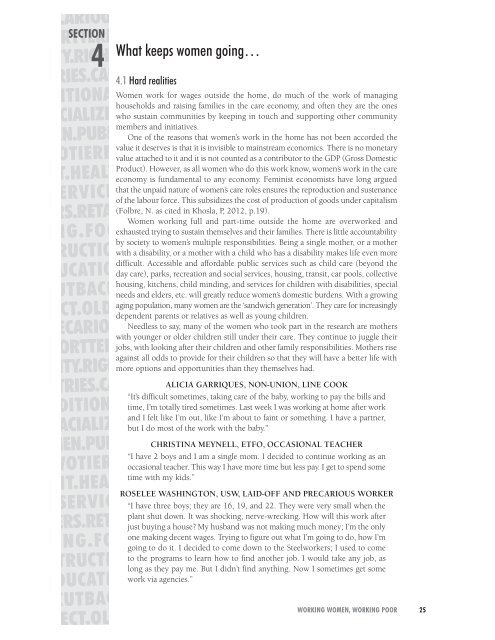workingwomenworkingpoor_letter_web
workingwomenworkingpoor_letter_web
workingwomenworkingpoor_letter_web
You also want an ePaper? Increase the reach of your titles
YUMPU automatically turns print PDFs into web optimized ePapers that Google loves.
SECTION4What keeps women going…4.1 Hard realitiesWomen work for wages outside the home, do much of the work of managinghouseholds and raising families in the care economy, and often they are the oneswho sustain communities by keeping in touch and supporting other communitymembers and initiatives.One of the reasons that women’s work in the home has not been accorded thevalue it deserves is that it is invisible to mainstream economics. There is no monetaryvalue attached to it and it is not counted as a contributor to the GDP (Gross DomesticProduct). However, as all women who do this work know, women’s work in the careeconomy is fundamental to any economy. Feminist economists have long arguedthat the unpaid nature of women’s care roles ensures the reproduction and sustenanceof the labour force. This subsidizes the cost of production of goods under capitalism(Folbre, N. as cited in Khosla, P, 2012, p.19).Women working full and part-time outside the home are overworked andexhausted trying to sustain themselves and their families. There is little accountabilityby society to women’s multiple responsibilities. Being a single mother, or a motherwith a disability, or a mother with a child who has a disability makes life even moredifficult. Accessible and affordable public services such as child care (beyond theday care), parks, recreation and social services, housing, transit, car pools, collectivehousing, kitchens, child minding, and services for children with disabilities, specialneeds and elders, etc. will greatly reduce women’s domestic burdens. With a growingaging population, many women are the ‘sandwich generation’. They care for increasinglydependent parents or relatives as well as young children.Needless to say, many of the women who took part in the research are motherswith younger or older children still under their care. They continue to juggle theirjobs, with looking after their children and other family responsibilities. Mothers riseagainst all odds to provide for their children so that they will have a better life withmore options and opportunities than they themselves had.ALICIA GARRIQUES, NON-UNION, LINE COOK“It’s difficult sometimes, taking care of the baby, working to pay the bills andtime, I’m totally tired sometimes. Last week I was working at home after workand I felt like I’m out, like I’m about to faint or something. I have a partner,but I do most of the work with the baby.”CHRISTINA MEYNELL, ETFO, OCCASIONAL TEACHER“I have 2 boys and I am a single mom. I decided to continue working as anoccasional teacher. This way I have more time but less pay. I get to spend sometime with my kids.”ROSELEE WASHINGTON, USW, LAID-OFF AND PRECARIOUS WORKER“I have three boys; they are 16, 19, and 22. They were very small when theplant shut down. It was shocking, nerve-wrecking. How will this work afterjust buying a house? My husband was not making much money; I’m the onlyone making decent wages. Trying to figure out what I’m going to do, how I’mgoing to do it. I decided to come down to the Steelworkers; I used to cometo the programs to learn how to find another job. I would take any job, aslong as they pay me. But I didn’t find anything. Now I sometimes get somework via agencies.”WORKING WOMEN, WORKING POOR 25


